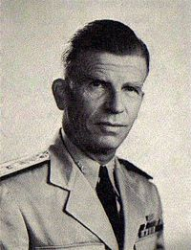
 |
|
|
||
|
Oscar Charles Badger II |
||||
|
Graduate, U.S. Naval Academy, Class of 1911 Engagements: • Occupation of Veracruz (1914)• World War I (1914 - 1918)• World War II (1941 - 1945) |
||||
| Biography: | ||||
|
Oscar Charles Badger II Admiral, U.S. Navy Medal of Honor Recipient Occupation of Veracruz Admiral Oscar Charles Badger II (26 June 1890 - 30 November 1958) was a U.S. Navy officer who received the U.S. military's highest award for valor, the Medal of Honor, for his heroic actions as a junior officer during the Occupation of Veracruz. He also served in both World Wars. Oscar Charles Badger II was born 26 June 1890 in Washington, DC. He was the grandson of Commodore Oscar C. Badger (1823-1899), son of Admiral Charles J. Badger (1853-1932) and a cousin of Secretary of the Navy, George E. Badger (1795-1866). He graduated from the U.S. Naval Academy in 1911. Naval Career Occupation of Veracruz As an Ensign in USS Utah (BB-31) in 1914, he participated in the U.S. occupation of Veracruz. Several thousand American troops landed in an effort to force out General Victoriano Huerta, who had seized power in Mexico. Fifty-five men were awarded the Medal of Honor for this action, including seven leaders of the battleship's 'bluejacket battalion.' Badger was one of the recipients. Medal of Honor Rank and organization: Ensign, U.S. Navy. Citation: For distinguished conduct in battle, engagements of Vera Cruz, 21 and 22 April 1914. Ens. Badger was in both days' fighting at the head of his company, and was eminent and conspicuous in his conduct, leading his men with skill and courage. World War I and Inter-War Service Badger served with the destroyer force in European waters during World War I. Following the war, he served as gunnery officer on various ships. He was then assigned to duty with the Bureau of Ordnance. World War II In 1941, Captain Badger took command of USS North Carolina (BB-55) and in 1942, after promotion to Rear Admiral, was Commander Destroyers Atlantic Fleet and subsequently Assistant Chief of Naval Operations for Logistics Plans. In February 1944 he became Commander Service Squadrons South Pacific and in October Commander Battleship Division 7. Badger was the first Navy officer to step ashore in Japan at the end of World War II. Postwar Service On 19 January 1948, Badger was promoted to Vice Admiral and the following month became Commander, Naval Forces, Far East. In that post, he observed the gradual loss of the Chinese mainland to Communist forces and supervised the retirement of American forces to port cities on the China coast. Following his service as Commander of Western Pacific naval forces, Badger was appointed as Commander, Naval Forces, Western Pacific, later commanding the Eleventh Naval District, and the Eastern Sea Frontier. On 19 June 1951, during congressional hearings on the loss of China, Vice Admiral Badger testified that the U.S. arms embargo against Nationalist China led to a loss of capability and morale that resulted in their defeat by Communist Chinese forces led by Mao Tse-Tung. He retired from the U.S. Navy in June 1952 with the rank of Admiral. Medals and Awards Medal of Honor Honors Officially, USS Badger (FF-1071) was named in honor of all the members of the Badger family who served in the U.S. Navy, but when she was launched in 1968, her sponsor, Isabelle Austen Badger, Admiral Badger's widow, said "I christen thee Oscar Charles Badger II!" Death and Burial Admiral Oscar Charles Badger II died on 30 November 1958. He is buried at Arlington National Cemetery in Arlington, VA, in Section 2, Lot 3760-WS. |
||||
| Honoree ID: 1978 | Created by: MHOH | |||
Ribbons
Medals
Badges
Honoree Photos
 |  |  |
 |  |
 |


